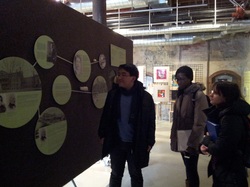Praxis II Topic Precis

At the Deaf Culture Centre with two of my teammates.
Overview: This stage required us to identify a community in need within the City of Toronto and present our community and its prospective needs to our assessors and colleagues.
Team: Fadime Bekmambetova, Rong Guan, and Jingyao (Jason) Li, Toluwanimi Odemuyiwa
Process in Action: During this phase of the design process, we were fully steeped in the first part of step one – establishing the need. During lectures, we learned the need is established from the community. In response to this, we brainstormed a list of communities and identified potential needs that could be explored for each of them. After iterating through six different communities, we used a decision making process to finally select an overarching community of Deaf people. To establish a more specific need, we went to the Deaf Culture Centre to speak to representatives of the community. In the end, we narrowed down the needs into three categories: improving pedestrian and cyclist safety for Deaf people, finding a way to digitally represent American Sign Language so that it can be typed like English words, and improving the way in which current building structures are designed to allow for accessibility in using American Sign Language. Our PowerPoint presentation can be found here. Our final need in the end was improving road safety for Deaf cyclists.
I want to thank the representatives at the Deaf Culture Centre for their willingness to answer all our questions regarding this design project. The following is a link to their website: Deaf Culture Centre
Team: Fadime Bekmambetova, Rong Guan, and Jingyao (Jason) Li, Toluwanimi Odemuyiwa
Process in Action: During this phase of the design process, we were fully steeped in the first part of step one – establishing the need. During lectures, we learned the need is established from the community. In response to this, we brainstormed a list of communities and identified potential needs that could be explored for each of them. After iterating through six different communities, we used a decision making process to finally select an overarching community of Deaf people. To establish a more specific need, we went to the Deaf Culture Centre to speak to representatives of the community. In the end, we narrowed down the needs into three categories: improving pedestrian and cyclist safety for Deaf people, finding a way to digitally represent American Sign Language so that it can be typed like English words, and improving the way in which current building structures are designed to allow for accessibility in using American Sign Language. Our PowerPoint presentation can be found here. Our final need in the end was improving road safety for Deaf cyclists.
I want to thank the representatives at the Deaf Culture Centre for their willingness to answer all our questions regarding this design project. The following is a link to their website: Deaf Culture Centre

